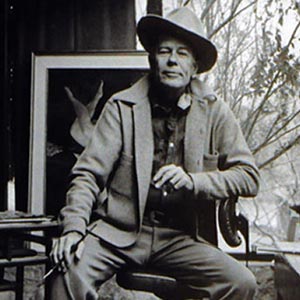About the Artist
 Philip Campbell Curtis was born on May 26, 1907 in Jackson, Michigan. He received a B.A. from Albion College where he had his first contact with painting. He began to study law at the University of Michigan but he truly wanted to pursue art and enrolled at the School of Fine Arts at Yale University. After graduation in 1936 he became an Assistant Supervisor of Mural Paintings for the WPA in New York and the following year the WPA sent him to Phoenix to establish the Phoenix Art Center which later became the Phoenix Art Museum. In 1939 he was sent to Des Moines, Iowa to assist in starting the Des Moines Arts Center also under the WPA Federal Arts Project. He began Museum Studies at Harvard University in 1941 intending to prepare for museum work. His schooling was interrupted by World War II service with the Office of Strategic Services in Washington, D.C. In 1947 he returned to Arizona and settled in Scottsdale to begin his life as an artist. In 1949 he had a solo exhibition at the San Francisco Museum of Art and at the Civic Drama Festival Playhouse in Phoenix. He then went on to show in New York City and Denver, and Ohio.
Philip Campbell Curtis was born on May 26, 1907 in Jackson, Michigan. He received a B.A. from Albion College where he had his first contact with painting. He began to study law at the University of Michigan but he truly wanted to pursue art and enrolled at the School of Fine Arts at Yale University. After graduation in 1936 he became an Assistant Supervisor of Mural Paintings for the WPA in New York and the following year the WPA sent him to Phoenix to establish the Phoenix Art Center which later became the Phoenix Art Museum. In 1939 he was sent to Des Moines, Iowa to assist in starting the Des Moines Arts Center also under the WPA Federal Arts Project. He began Museum Studies at Harvard University in 1941 intending to prepare for museum work. His schooling was interrupted by World War II service with the Office of Strategic Services in Washington, D.C. In 1947 he returned to Arizona and settled in Scottsdale to begin his life as an artist. In 1949 he had a solo exhibition at the San Francisco Museum of Art and at the Civic Drama Festival Playhouse in Phoenix. He then went on to show in New York City and Denver, and Ohio.
In 1961 the Curtis Trust was formed by Lewis J. Ruskin and a group of nine other patrons from Phoenix to provide financial support for Curtis allowing him to focus on painting for three years. This allowed him to create a body of work that was exhibited all over the United States and internationally. In 1981, a permanent exhibition of Curtis’s work opened at the Phoenix Art Museum. In 1999 construction began for the Ullman Center for the Art of Philip C. Curtis at the Phoenix Art Museum. Philip C. Curtis passed away at this home and studio in Scottsdale November 12, 2000. The Ullman Center for the Art of Philip C. Curtis opened in 2001. Please click here to view the full chronology and click here for the bibliography.
What the Critics Say
“Philip C. Curtis is a unique artist, and American original whose life and work have spanned and absorbed the art history of virtually the entire twentieth century. His charming, exquisitely crafted paintings, in unique frames selected and integrated by the artist, present an imagined vision of Americana influenced by the magic world of the circus and entertainment and by the artists memories of his turn-of-the-century childhood in Michigan. They combine people (often in period costumes) and musical instruments with invented, isolated, boundless settings in intense colors and in moods that echo surrealism, magic realism, and realism. The figures in Curtis’s paintings are in effect characters in a plot staged by the artist. Curtis said, “I treat the canvas as a stage and the people I use belong to an acting company of mine.”
Philip C. Curtis’s provocative paintings, like those of Rene Magritte, stimulate and enchant our minds as well as out eyes, delighting us with their brain-teasing takes on the nature of art and the foibles of living. The loneliness they sometimes portray is softened by the artists evident fascination with rituals and activities summoned up by his memories of the past.” (From American Dreamer: The Art of Philip C. Curtis)
Selected Public Collections
Albion College, Albion, Michigan
Arizona Public Service Company, Phoenix
Bank One, Arizona
Des Moines Art Center, Des Moines, Iowa
Museum of Art, University of Arizona, Tucson
Museum of Modern Art, New York, New York
National Museum of American Art
Smithsonian Institution, Washington, D.C.
Northern Arizona University, Flagstaff
Phillips Collection, Washington, D.C.
Phoenix Art Museum, Arizona
Pinnacle West Capital Corporation, Phoenix
Rose Art Museum, Brandeis University
Waltham, Massachusetts
Snite Museum of Arts, University of Notre Dame
Notre Dame, Indiana
University Art Museum, Arizona State University
Tempe Arizona
